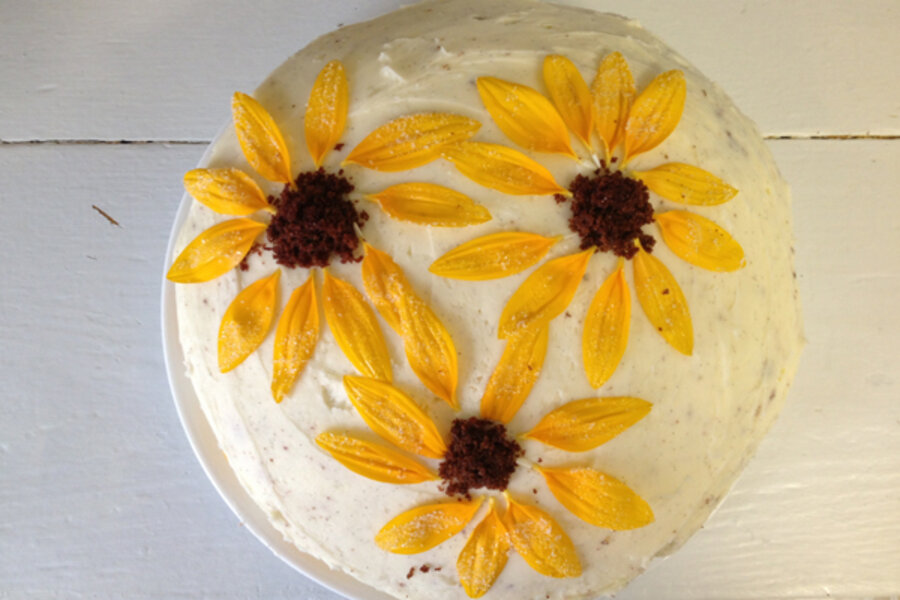By Laura Edwins, Contributor
1 cup boiling water
2 sticks butter
4 heaping tablespoons unsweetened cocoa powder
1 box (8 ounces) semi-sweet baker's chocolate
1/2 cup buttermilk
1 teaspoon baking soda
2 eggs
1/2 teaspoon vanilla extract
2 cups flour
2 cups sugar
1/4 teaspoon salt
Sugared sunflower petals
1 large sunflower
1 egg white
3-4 tablespoons granulated sugar
Special supplies: small paint brush and wax paper
Vanilla bean buttercream frosting
6 cups powdered sugar, sifted
4 sticks butter, softened
1 large vanilla bean, caviar scraped out
1 dash salt
4 tablespoons half-and-half
1/4 teaspoon vanilla extract
1. Preheat oven to 350 degrees F. Grease and flour two round cake pans. Cut two circles of wax paper and line bottoms of floured cake pans.
2. In a small saucepan or the microwave, bring 1 cup water to a boil. Meanwhile, in a medium saucepan, melt 2 sticks of butter and whisk in 4 tablespoons cocoa. Pour in boiling water, let the mixture bubble up for 30 seconds, then turn the burner to low. Add baker's chocolate and stir until melted. Remove pan from heat and set aside to cool.
3. In a measuring cup mix together the buttermilk, baking soda, eggs, and vanilla extract. Set aside.
4. In a large mixing bowl, whisk together flour, sugar, and salt. Pour chocolate mixture into the bowl, stirring to slightly cool it. Pour in the buttermilk mixture and whisk until smooth.
5. Pour batter into prepared cake pans and bake for 16-18 minutes, or until done (my baking time was closer to 22-25 minutes). Remove cakes from oven, and let cool in pans 2-3 minutes. Carefully run a butter knife around the edges of each pan, using pot holders, invert cakes on wire cooling rack, peel off wax paper, let cool completely.
6. Make the sugared flowers: Pluck all the petals from from the sunflower. Rinse thoroughly in a colander, and pat dry with a paper towel. Separate egg white into small bowl, and measure sugar into another. Spread a piece of wax paper on your work surface.
7. Working in small batches, 5 or 6 petals at a time, use the paintbrush to apply egg white to both sides of each petal. Place them on wax paper as you work, and when you have a few brushed, "dip" or drag them in the bowl of sugar. Repeat until all petals are sugared. Leave them spread out on wax paper until ready to use.
8. Make the frosting: Measure and sift powdered sugar into large bowl. (If you're like me, and don't have a sifter, use a whisk to break up any clumps of sugar.) In bowl of stand mixer (or with hand mixer) beat the butter until fluffy. Slice open the vanilla bean, scrape out caviar, and add it to the bowl. Slowly add powdered sugar; turn off mixer completely, add a little sugar, then mix on a low for a minute until sugar is incorporated, then mix on high for a minute. Repeat until all sugar is mixed, then add salt, and beat until fluffy. Add half-and-half and vanilla extract and beat until totally fluffy.
9. Decorate the cake: Level the first layer, and place it flattest side up on a platter or cake stand. Set aside the extra cake crumbs. Slide little strips of wax paper under the first layer of cake to keep your plate clean of icing. Spread a good layer of icing on top of the first layer of cake. Level the second layer of cake, and place it flattest side up on top of the first layer. Thinly ice the top and sides of the cake, leaving a good amount of icing in the bowl (and being sure not to mix cake crumbs in the icing bowl).
10. Refrigerate the cake for at least half an hour. Do not refrigerate the frosting. (Now's a good time to tackle cleaning up part of your kitchen.) Remove the cake from fridge, and frost the top and sides again, as smoothly as you can. Decorate with flower petals and cake crumbs, or a frosting decorator, or any other decorations you wish. Remove the wax paper and let cake come to room temperature before serving.
Read the full post on Stir It Up!








